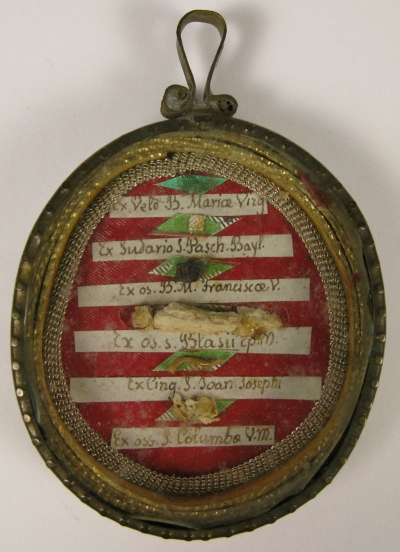According to tradition, the Veil of the Blessed Virgin Mary was worn by the Virgin as she stood at the foot of the Cross. It had been transferred in the early years of Christianity from Jerusalem to Constantinople when it was presented by the Byzantine Empress Irene to the Holy Roman Emperor Charlemagne. In 876 his descendant Charles the Bald gave the relic to the cathedral at Chartres. The Veil is kept in a golden reliquary beside the high altar and has formed the focus of many traditions throughout the centuries. It was believed to have protected the faithful down through the centuries from many dangers and evils, including famine and war, outbreaks of the plague, and the worst ravishes of the French Revolution. The veil itself is more than six meters long and made of silk. Scientific studies have shown that it is of Syrian design, of fine quality and can be traced to the first century. Every year on 15th August, the Feast of the Assumption of Our Lady, the Veil is processed through the town of Chartres.
Saint Paschal Baylon (†1592) was a Spanish friar and is a saint in the Roman Catholic Church noted for his strict austerities which he imposed upon himself as well as his love for and compassion towards the ill but best known for his strong and deep devotion to the Eucharist. Pope Paul V beatified him in 1618 while Pope Alexander VIII canonized him later in 1690. He is known as the "Seraph of the Eucharist" and is the patron saint of Eucharistic congresses and Eucharistic associations.
Saint Mary Frances of the Five Wounds, T.O.S.F. (Italian: Maria Francesca delle Cinque Piaghe, (†1791), was an Italian member of the Third Order of St. Francis, who is honored as a saint in the Catholic Church. She is said to have received the wounds of the stigmata and suffered patiently many physical afflictions and spiritual trials. She would wear gloves to cover the marks on her hands, while she did her work. She is also said to have had visions of Saint Raphael the Archangel, who healed her of several afflictions. She was beatified by Pope Gregory XVI in 1843 and soon canonized by Pope Pius IX on in 1867. She is a holy patron of Quartieri Spagnoli of Naples (co-patron); Gallo World Family Foundation; expectant mothers; and women seeking to have children and Her feast day is celebrated on 6 October. In 2001, her remains were transferred from the Church of Santa Lucia to the house where she had spent the last half of her life. It is now the Shrine of St. Mary Frances of the Five Wounds. It is still a common practice for expectant mothers to go there to be blessed with her relic. Many votive offerings from mothers who credit her with their successful deliveries are displayed in the sanctuary.
Saint Blaise, also known as Saint Blase, was a physician, and bishop of Sebastea in historical Armenia. According to the Acta Sanctorum, he was martyred by being beaten, attacked with iron combs, and beheaded. He is the patron saint of wool combers. In the Latin Church his feast falls on 3 February, in the Eastern Churches on 11 February. Patron of Animals, builders, choking, veterinarians, throats, infants, Maratea, Italy, Sicily, Dalmatia, Dubrovnik, Ciudad del Este, Paraguay, Rubiera, stonecutters, carvers, and wool workers.
Saint John Joseph of the Cross (†1739) was an Italian priest and a professed member from the Order of Friars Minor who hailed from the island of Ischia off the coast of Naples. He had a reputation for austerity and for the gift of miracles.He was beatified under Pope Pius VI in 1789 and was later canonized as a saint on 26 May 1839 under Pope Gregory XVI. His feast day is commemorated on March 5th.
Saint Columba of Spain, or Columba of Cordova (Cordoba), was a nun who was born in Cordoba, Spain and martyred around 853 by the Moors. According to the Tradition, before becoming a virtuous virgin martyr, Comba was a witch. One day, the witch Comba, encountering Jesus Christ on a Galician road, changed her life after Christ remarked, “Go ahead and be the witch, but you will not enter my kingdom.” She converted to Christianity and was martyred for her faith after refusing to deny it and after refusing the sexual advances of men. She became the patron saint of witches in Galicia, acting both as an intercessor on behalf of witches and as an intercessor against witches. Her feast day is commemorated on September 17th.






 Change language to English
Change language to English